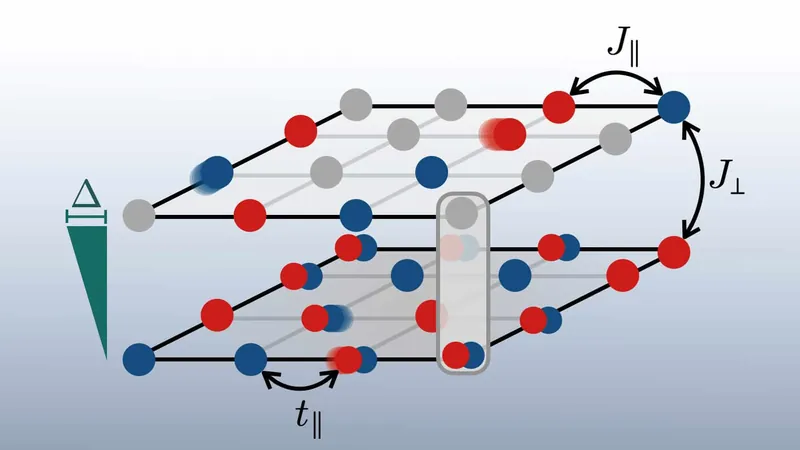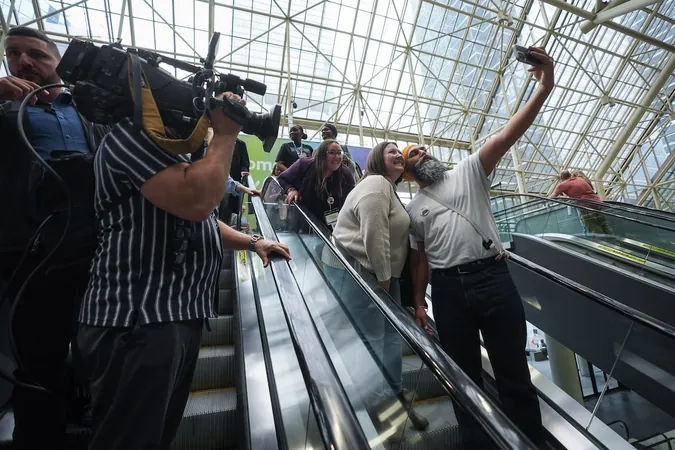
Breakthrough Experiment to Decode High-Temperature Superconductivity!
2025-04-14
Author: Sophie
A groundbreaking experiment is on the horizon, aiming to trap atoms on a revolutionary two-layer laser grid. Spearheaded by physicists from Germany and France, led by Henning Schlömer, this innovative technique could unveil the mysteries behind high-temperature superconductivity—a phenomenon that has puzzled scientists for over a century!
What is Superconductivity?
Superconductivity is a fascinating occurrence where certain materials experience a sudden drop to zero electrical resistance when cooled below a specific critical temperature. While conventional superconductors with low critical temperatures are relatively understood, high-temperature superconductors remain shrouded in mystery. Cracking this code could open new doors to understanding macroscopic quantum phenomena in numerous many-body systems.
Harnessing the Power of Optical Lattices
Enter optical lattices—an extraordinary tool that allows researchers to mimic the properties of real crystalline materials. These lattices are formed by overlapping two counter-propagating laser beams, creating a standing wave that traps atoms in a grid of potential-energy minima. The interactions among these trapped atoms can be finely adjusted, offering a groundbreaking way to explore their characteristics.
Unlocking Superconductivity Through Atom Pairing
In superconductors, long-range correlations between electron pairs are critical. While electronic properties of high-temperature superconductors can be assessed in the lab, verifying hypotheses can be tricky due to the fixed nature of each superconductor. By manipulating atomic correlations in an optical lattice, scientists could explore diverse theoretical models and parameters.
Introducing a Novel Protocol
Schlömer and his team propose an innovative method to trap fermionic atoms—akin to electrons in superconducting materials—on a two-layer lattice. By creating a potential-energy offset between the layers, the atoms remain confined to their respective layers, curbing interlayer hopping while promoting magnetic interactions that foster spin-correlations like singlets, which feature opposing spins. This arrangement could lead to superconducting behavior!
The Mixed-Dimensional Bilayer Model
The research utilizes a ‘mixed-dimensional bilayer’ (MBD) model, accounting for atom hopping within layers, magnetic interactions between the layers, and intra-layer magnetic dynamics. Simulations from this model hint at superconductor-like behavior manifesting at critically high temperatures—temperatures that are actually achievable in experimental settings!
Pioneering Measurement Techniques
To measure atomic pair formation within the lattice, the team cleverly proposes doping the higher energy layer with holes—removing atoms to create vacant sites—and filling the lower layer with doublons, which are atom pairs occupying single lattice sites. This method enables controlled interactions between holes and doublons, sidestepping the difficulties of directly adding or removing atoms.
A Mathematical Marvel for Superconductivity Discovery
The researchers employ an ingenious mathematical transformation. By shifting to a model using only 'hole-type' dopants, they can map superconducting correlations to easily measurable density correlations. This groundbreaking technique allows for studying superconducting behaviors without invasive measures.
A Bright Future Ahead!
With this proposal, Schlömer and his colleagues are poised to create optical lattices conducive to superconducting behavior at experimentally accessible temperatures. While some technical complexities remain, Schlömer expresses optimism: “The technology is already in place, and we anticipate these experiments will become a reality soon!” This could potentially revolutionize our understanding of superconductivity and the quantum world, marking a significant leap in modern physics!









 Brasil (PT)
Brasil (PT)
 Canada (EN)
Canada (EN)
 Chile (ES)
Chile (ES)
 Česko (CS)
Česko (CS)
 대한민국 (KO)
대한민국 (KO)
 España (ES)
España (ES)
 France (FR)
France (FR)
 Hong Kong (EN)
Hong Kong (EN)
 Italia (IT)
Italia (IT)
 日本 (JA)
日本 (JA)
 Magyarország (HU)
Magyarország (HU)
 Norge (NO)
Norge (NO)
 Polska (PL)
Polska (PL)
 Schweiz (DE)
Schweiz (DE)
 Singapore (EN)
Singapore (EN)
 Sverige (SV)
Sverige (SV)
 Suomi (FI)
Suomi (FI)
 Türkiye (TR)
Türkiye (TR)
 الإمارات العربية المتحدة (AR)
الإمارات العربية المتحدة (AR)